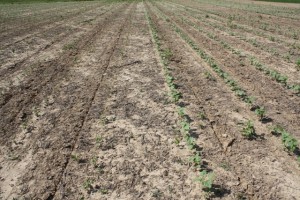THRIPS continue to plague some cotton, and treatments are still being made and needed on some cotton that is fourth and fifth leaf. Clearly much of this is due to high pressure and poor weather conditions during emergence nearly a month ago. Not making timely treatments at the first and second leaf cotton has also resulted in a later than normal need for foliar thrips application. Much of this was to be expected given the tight schedule that growers were on in planting and replanting. However, there has also been some control “failures” of insecticide seed treatments. In these examples, two or even three applications for thrips have been justified. Most complaints have been on cotton planted May 5-15 and where Cruiser was used. Phytogen 375 WRF was another commonality, but this is not too surprising considering how much of our acreage is planted with this variety.
I can’t explain why there is a discrepancy between the performance of Gaucho (imidacloprid) and Cruiser. These treatments have always been very similar in over a decade’s worth of research in the Midsouth. Indeed, they appear similar in my test plots this year, although in cotton, imidacloprid treatments have the edge. I included some pictures contrasting Cruiser and untreated cotton seed (below) for Phytogen 375 WRF planted in Madison County on May 9th. In this demo, the value of seed treatment is very evident against substantial thrips infestations. Regardless, this has been a year when foliar applications of insecticides for thrips have paid off in many cases. Most cotton planted after May 20th has done considerably better.


Now, as we are passing through the thrips window, what is next? Our earliest cotton will soon be squaring. TARNISHED PLANT BUGS will often concentrate in the earliest fields in an area, so vigilant scouting is in order. This means getting out the sweep net and checking fields every 4-5 days. Square loss exceeding 20% will potentially further delay our crop. Monitoring square retention is an important component of sampling for plant bug feeding. During the first two weeks of squaring, treatments should be made anytime populations reach or exceed 8 plant bugs per 100 sweeps, or for even lower populations if square retention is low. Prior to flowering, UT recommends neonicotinoid insecticides such as imidacloprid Centric or Intruder. Carbine, which belongs to a different class, is another option. Suggested rates are listed in the UT’s Cotton Insect Control Recommendations. I strongly suggest avoiding the use of pyrethroid insecticides and OP’s (e.g., acephate) prior to flowering. This is for resistant management reasons and to prevent creating secondary pest problems such as spider mites and aphids. Remember, Bidrin or any product containing dicrotophos is NOT labeled for use between first square and first bloom.
Note: There are many different products containing imidacloprid, and the amount of active ingredient per gallon varies considerably from 1.6 to 4.6 lb/gal. Be sure to adjust your rate based on the concentration of active ingredient in the product you use. Bayer CropScience is back in the imidacloprid business with Admire Pro (4.6 lb ai/gal). This is more concentrated than other commercially available imidacloprid products.
Speaking of SPIDER MITES and APHIDS, we should anticipate some higher than normal infestations. The repeated sprays needed for thrips have set us up for potential problems. The good news is that there are currently no reported infestations. The recommended plant bug products mentioned above will help alleviate aphid infestations.
Note: Aphid resistance to neonicotinoid insecticides such as Cruiser, Intruder and Imidacloprid has been documented in parts of Mississippi, Louisiana and Arkansas. Don’t be surprised and please report any control problems!

